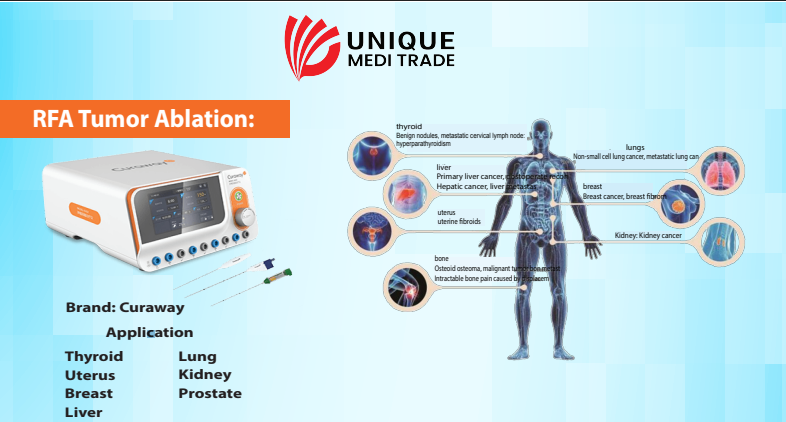World’s Latest Treatment Procedure for Uterine Fibroids (2025)
RFA is currently considered the best balanced modern treatment for uterine fibroids in terms of safety
1. Radiofrequency Ablation (RFA) – Uterus-Preserving, Minimally Invasive
What is it?
- RFA uses controlled radiofrequency energy to heat and shrink fibroids without removing the uterus.
- It can be done laparoscopically, transvaginally, or transcervically (like Sonata® System).
Why It’s Best:
✅ Minimally invasive (small incisions or natural orifice)
✅ Uterus preserved (important for fertility & emotional well-being)
✅ Quick recovery (back to normal life in 3-5 days)
✅ Less blood loss than myomectomy
✅ Outpatient procedure in many cases
✅ Safe & effective even for multiple fibroids
🌟 2. High-Intensity Focused Ultrasound (HIFU/MRgFUS)
What is it?
- HIFU uses focused ultrasound waves (guided by MRI or ultrasound imaging) to heat and destroy fibroid tissue from outside the body (non-invasive).
Why It’s Best:
✅ Non-invasive (no incisions)
✅ Daycare procedure
✅ Precise targeting with minimal damage to surrounding tissue
✅ Suitable for selected fibroid types & locations
✅ Quick return to normal activity
🌟 3. Uterine Artery Embolization (UAE/UFE)
What is it?
- UAE blocks the blood supply to fibroids, causing them to shrink.
Why It’s Still Relevant:
✅ Minimally invasive (done via femoral or radial artery)
✅ Effective for large fibroids
✅ Good alternative for non-surgical candidates
⚠️ But has higher risk of affecting ovarian function and fertility compared to RFA/HIFU.
🌟 4. Microwave Ablation (MWA) – Emerging Technology
What is it?
- Uses microwave energy to destroy fibroid tissue via a thin needle probe.
Why It’s Promising:
✅ Faster heating than RFA
✅ Larger ablation zone
✅ Minimally invasive
⚠️ Still under study for broader fibroid treatment, mainly used in China & selected centers.
Why RFA is Considered the Best Balance (2025):
| Criteria | RFA (Radiofrequency Ablation) | MWA (Microwave Ablation) |
|---|---|---|
| Clinical Experience in Gynecology | Long established in gynecology, FDA & CE approved for uterine fibroids | Limited data, mostly used in liver, lung, kidney |
| Precision | Highly controllable, predictable ablation zone | Less precise, risk of overheating surrounding tissues |
| Heat Distribution | Uniform, controlled spread | Faster, but uneven heating, potential over-treatment |
| Tissue Charring Risk | Minimal | Higher due to rapid heating |
| Safety Profile in Uterus | Proven safety in delicate uterine tissue | Less data, higher theoretical risk of damage |
| Global Guidelines | Included in gynecology guidelines (ACOG, ESGE) | Not yet included specifically for fibroids |
| Equipment Availability | Widely available for gynecological use | Primarily oncology-focused systems |
| Patient Tolerance | Excellent, minimal pain and fast recovery | Limited experience in gynecology, discomfort reported in some cases |
| Cost Efficiency | Cost-effective for fibroids | Higher device cost and maintenance |
| Future Fertility | Preserved in most cases | Safety for fertility not well established |
Summary Verdict:
-
RFA is currently considered the best balanced modern treatment for uterine fibroids in terms of safety, efficacy, uterus preservation, and recovery.
-
HIFU is very attractive for non-invasive options but has limited availability & patient selection criteria.
-
UAE is good but less preferred for women who want to preserve fertility.
-
MWA is an emerging contender but needs more global validation.
Contact Unique Medi Trade
For the latest RFA systems, wireless ultrasound, and complete minimally invasive gynecological solutions:
📞 +8801717811312
📧 uniquemeditrade@gmail.com
🌐 https://uniquemeditrade.com/

